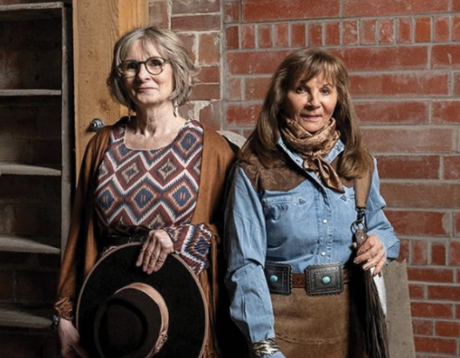The Badger newspaper online
Cattle Rustled
SPECIAL?REPORT
By Sheri Monk
While cattle rustling has been around for as long as cattlemen have been ranching, when it actually happens, it can take any cowboy by surprise.
Bob and Jill Jensen, Leader area ranchers, were victims of cattle theft in 2009 and on Monday, Dec. 6, 2010, the perpetrator pleaded guilty in a North Battleford courtroom, receiving a nine-month conditional discharge.
But while the Jensens are pleased with both the plea and sentence, they’re furious with government bureaucrats who, they say, refused to stand behind the onerous and expensive government cattle tagging system that is the bane of every rancher.
The Jensens turn out some of their cattle to graze on rented private pasture every spring, just as they did in May of 2009. But when they rounded up their cattle that fall, four head were missing.
“Our cows came home from North Battleford on Oct. 17 and we were two pairs short. Eventually the brand inspector phoned us and the two calves ended up in the Spiritwood auction mart on Oct. 27,” said Bob. “We don’t know how long he had them. You have to think that when the cows came home the 17th and they weren’t there, that he already had them by then. He could have had them for two weeks before that – we have no idea how long he had them,” said Bob.
The purebred angus heifer calf and bull calf were branded with the Jensen’s cactus brand – L1 backward L over 1 – and Bob credits the brand and the brand inspectors with the safe return of the livestock.
“The only reason this was found out was because of the brand and the brand inspectors. Branding is tradition, but it’s still used because it still works – it’s the only thing that still works today,” Bob said emphatically.
The calves hadn’t been branded again and blood on the Canadian Cattle Identification Agency (CCIA) Radio-frequency identification (RFID) tags were another visual clue that rustling was afoot. The tags the Jensens had put in had been removed and the calves were outfitted with new RFID?tags.
The calves were not sold that day at auction and were returned to the Jensens. The suspect was turned into the RCMP, along with the evidence the brand inspectors collected. But the mother cows of the two calves were still missing, temporarily.
“It was probably another week or more before them cows showed up. The brand inspectors, they did a great job. They were out talking to neighbours and we had a good description of the cows. We had good yellow dangle tags in them, and I knew the description of the cows and they were noticeable, so I could pass them on. The brand inspectors said both of them were seen in the area so there was a pretty good hope they’d both be alive and eventually, they both showed up in two different places. They were just in the ditch running up and down the side roads.?They each ended up in a separate farm yard in with other people’s cattle,” said Bob, adding he was thankful the cows didn’t cause a wreck on the roads.
The brand inspectors at Spiritwood Stockyards who caught the theft in progress are Ward Anderson and Ken Wasden. Anderson and Wasden were assisted in their investigation by district supervisor Ron Sabin, out of North Battleford.
Rick Omelenchenko?was charged with and later pled guilty to theft under $5,000. On top of the nine-month conditional discharge he was ordered to pay a $500 restitution to the Jensens and an additional $500 donation to a local charity. However, the Jensens were very upset to learn that tag tampering charges would not be going forward.
“The Crown prosecutor phoned me and she was madder than hell when she told me they dropped the charges. And I was madder than hell so I asked her who had contacted her and she told me and I phoned him.?Eventually I?was able to get ahold of him and went up one side of him and down the other,” said Bob. “He told me their lawyer told him to drop the charges.”
Bob says he spoke to Dwayne Galambos, who works in Saskatoon within enforcement investigation services for the Canadian Food Inspection Agency.
“I?was very disappointed. I said to him, ‘You’ve shoved this (identification system) down our throat for how many years now, your inspectors out there have no common sense and now you’ve got a chance to prosecute somebody for removal of these tags and you just drop the charges?’ They had an opportunity here and they did nothing with it,” exclaimed Bob.
Provincial crown prosecutor Jennifer Robertson says the brand inspectors approached her with the file in hopes she’d latch onto it because of her family’s ranching background.
“This was a clear cut case of theft. I am glad the inspectors caught it,” she said, adding the work the brand inspectors did was the only reason the case was able to proceed. “I think it was important that those cattle were branded because I found that there were a number of holes in the tagging system – it wasn’t as clear cut as you would think, but we had a strong case because we had the brands and the brand inspectors caught it right away.”
Robertson handed all the evidence over to the federal crown in the case and she said she still doesn’t completely understand the reasons why charges weren’t laid at that level for tag tampering, but believes there are differences in the burden of proof. However, she said that like the Jensens, she was personally disappointed as well.
“If you’re going to make people tag cattle with those tags, then you should enforce the regulations,” Robertson said.
The Badger has learned the regulation has never been enforced and there hasn’t been a single person charged with tag tampering.
The Jensens, like most producers in?Canada, have endured the extra costs associated with implementing national livestock identification initiatives in an effort to assure public and international confidence in Canada’s beef supply in a post-BSE world. However, the extra financial burden has been a heavy cross to bear during the seven-year slump in the cattle industry after BSE was discovered in 2003.
“Not everybody went and put bar code tags in all their cows, but because our cows are purebred and for the good of the industry, because we have our cows transported lots, we did that. We put 220 tags in at a cost of $3 to $3.50 a tag and now they’re telling us we have to do it again (with RFID),” Bob vented.
In calving season, ranchers have to invest heavily in vaccinations, medications, vet bills and now, tags for every new calf born. After a tough winter during a hay shortage and high feed costs, spring can be a tough go for any cow-calf operation. Bob says the justice system squandered an ideal opportunity to show ranchers the value of the RFID system by prosecuting the man who had stolen the Jensen’s cattle.
Robertson says cattle theft happens more often than most people would think. Earlier this week, it was learned that 20 pair went missing from a Bottrel, Alberta ranch sometime in October. If cattle prices continue to rise, thieves may be more likely to attempt to rustle. Robertson is hopeful other prosecutors will see the value and importance of holding rustlers’ feet to the fire.
“I think it takes someone who knows what is at stake for the victims, who can look at the whole picture and is maybe willing to go out on limb. I am really surprised at how prevalent it (cattle theft) is. Once you start getting the word out that we are prepared to prosecute for this, it should act as a deterrent,” she said.
Robertson says Saskatchewan relied heavily on its brand inspectors to catch acts of theft – more so than its provincial neighbour to the west.
“Alberta has a lot more resources – they have a RCMP member that is dedicated to tracking missing catle. In Saskatchewan we don’t, we really rely on the brand inspectors to catch these guys at the stockyard.”
The Jensens say they have seen CFIA inspectors out in the field performing inspections at community pastures, checking to make sure that every animal has a RFID tag before being turned out to graze. Bob believes that since ranchers are doing their part to make the system work, the CFIA must to work with cattlemen, not against them, by prosecuting those who have deliberately done wrong and by not focusing on the average rancher who may have forgotten to tag an old cow or two.
“He (Galambos) tells me that for the good of the industry, us producers should be quiet, put them tags in and go on with it. I?talked to him at the end of April – we brand the fourth of May – and I?said to him, ‘We’re going to brand here in a week and if I don’t hear from you that you’ve put these charges back on this fella, I’m not going to CCIA tag another calf on this outfit and there won’t be another rancher in this country that’ll do it either.’ He told me that was against the law and I?told him I was going to make Goddamn sure that people hear about this,” said Bob angrily. “It’s nice to be run by somebody from behind a fricking desk that has no idea what really goes on. When they start to push this stuff down a cowboy’s throat, there’s going to be trouble.”
The Jensens say they still believe that Canada needs some sort of national identification system, but they encourage everybody to continue branding, whether the cattle are pure bred or commercial.
“You can’t drive by a cow and read her CCIA tag or a tattoo, but you can read her brand. Every time we go out on the pasture there’s a tag lying around. And whether it gets hooked on a barb wire fence – it’s not just bales with the strings still in them that are ripping them out – It’s a joke. But if there’s a cow at a neighbour’s place, five miles or more from home, you know whose brand it is,” explained Bob. “Today if I have a cow or calf in our bunch that’s not mine, it’s just got a CCIA tag in it, I?don’t have a clue who to return it to. I?have to read that number, phone the CCIA and give them the number and they won’t even tell you who it is. Not even the brand inspectors will know who it is, the CCIA?won’t tell them either.”
The tags are costly and cattlemen frequently check on cattle, only to discover that many tags have been torn out. Bob estimates that 25 per cent of cattle will lose their tags over their lifetime, based on what he has observed. When a tag is lost, ranchers are required to report the number associated with the lost tag to the CCIA to retire it, and to report the number of the new replacement tag to ensure traceability. And, he says, like most ranchers, he has adhered to the new policies for the good of the industry. He says he recently had to re-tag two full-grown bulls because both had torn out their RFID?tags.
“We put our life on the line to do that, but then they tell me they’re not going to process this case because they don’t want to? But yet, I had to do that, I?did my part. They had a chance to stand behind their product and show us it was going to work and they didn’t do it. They didn’t care enough to bother,” said Bob. “Why would I?tag another animal? What would be the point?”
.















